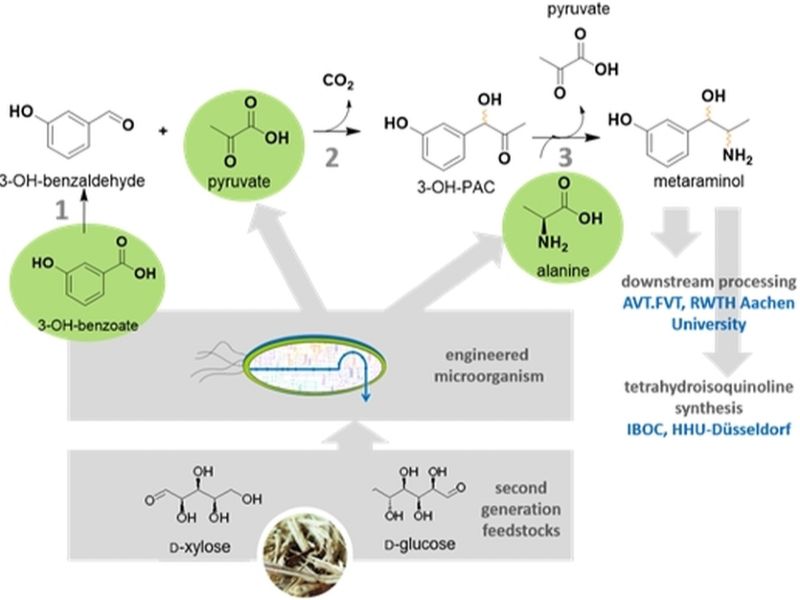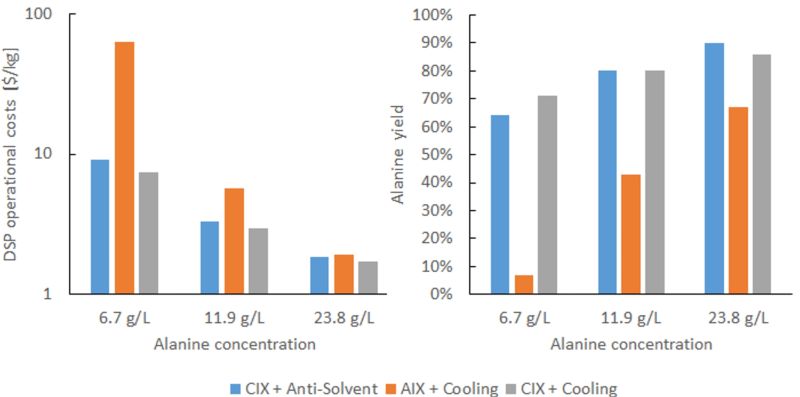Bio- and chemo-transformations to metaraminol and tetrahydroisoquinolines
Metaraminol is an active pharmaceutical ingredient used to treat low blood pressure and additionally serves as a chiral precursor for more complex bioactive compounds such as THIQs. Within “HyImPAct” suitable biocatalysts with high activity could be obtained for all cascade steps towards metaraminol, especially for the conversion of substrates from cell-free supernatants of the upstream microbial bio-transformation (Fig. 1).

First, a three-step enzymatic cascade is used to convert the various biobased precursor 3-hydroxybenzoate, pyruvate and alanine into metaraminol. Starting from 3-hydroxybenzoate, a carboxylate reductase (CAR (1)) generates the aromatic aldehyde 3-hydroxybenzaldehyde, which is then ligated with pyruvate by a pyruvate decarbocylase (PDC (2)) to form a hydroxyketone (3-hydoxy-PAC). Subsequently, a transaminase (TA(3)) converts the hydroxyketone to metaraminol using alanine as amine donor.
The first step of the cascade could be made more efficient by a concept for in-vitro regeneration of the cofactors used. The PDC used in the second reaction step demonstrated high activity and stereoselectivity in the cell-free supernatants employed, allowing the complete conversion of 40 mM 3-hydroxybenzaldehyde in only eight hours with a very good stereoselectivity of over 94% ee (enantiomeric excess).

However, a greater challenge arises for the third cascade step, where alanine serves as a biobased co-substrate. Here, a transaminase is employed that uses alanine as a green alternative to otherwise toxic and petroleum-based amine donors and achieves targeted amination with high stereoselectivity.
Typically, isolation of alanine from culture supernatants is achieved by crystallization. To obtain crystals of high purity, a wide range of different impurities must be separated. This typically involves a chromatography step. After evaluating different combinations of chromatography and crystallisation processes, as well as different alanine concentrations, a cation exchange chromatography (CIX) process with subsequent cooling crystallization was chosen as the final DSP because this setup has the lowest operating cost per gram of product across all product titers. For all variants investigated, the alanine yield increases at higher initial concentration, as the total amount of product lost remains almost constant within a process design. This leads to significantly lower specific DSP costs for higher alanine titers. The resulting crystals can then be used for the enzymatic production of metaraminol.

In this case, the resulting biocatalytic reaction operates very close to thermodynamic equilibrium, leading to low yields in the range of 15-20% metaraminol without auxiliary technical measures. Therefore, to increase the reaction yield, an in-situ product separation process (ISPR) was developed in collaboration with the Chair of Fluid Process Engineering at RWTH Aachen University. Using two different liquid-liquid extractions, the concept enables an increased metaraminol yield and minimizes waste streams, since the production and a first downstream step of metaraminol could be realized in a common process. In addition, a comprehensive organic solvent screening was performed with the transaminase used, which showed high enzyme activity and stability in the presence of the selected organic extraction phase.

Combined with optimized isolation of alanine from substrate supernatants, the overall metaraminol yield increased, contributing significantly to the performance of the overall hybrid process. Furthermore, efficient product recovery was achieved by re-extraction, minimizing additional process steps and waste streams, while the by-product pyruvate is retained for recycling within the enzyme cascade.
In a final step, metaraminol can be converted into a wide range of THIQs. For this purpose, chemical synthesis approaches based on the Pictet-Spengler reaction were developed and optimized for the application of biobased metaraminol as substrate (Fig. 1).
Prof. Jörg Pietruszka
Andreas Sebastian Klein
Anna Christina Alberecht
Bioorganic Chemistry
HHU Düsseldorf
Prof. Wolfgang Wiechert
Dr.-Ing. Stephan Noack
Prof. Dörthe Rother
Mohamed Labib
Christian Brüsseler
Laura Grabowski
Kevon Mack
Douglas Weber
Jochem Gätgens
IBG-1 Biotechnology
Forschungszentrum Jülich
Prof. Andreas Jupke
Moritz Doeker
Christian Kocks
Thomas Fuchs
AVT - Fluid Processing
RWTH Aachen University
Prof. Michael Bott
Prof. Jan Marienhagen
IBG-1 Biotechnology
Forschungszentrum Jülich